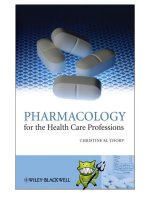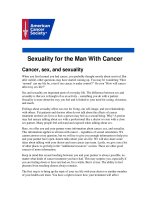Medical Law, Ethics, & Bioethics FOR THE HEALTH PROFESSIONS 6edition doc
Bạn đang xem bản rút gọn của tài liệu. Xem và tải ngay bản đầy đủ của tài liệu tại đây (5.53 MB, 290 trang )
Icons are used throughout the text as visual cues to the
reader that a topic has a particular significance in one of
the following areas:
Law
Ethics
Key Topic
Culture/Diversity
HIPAA Law
00Lewis(F)-FC 4/12/07 6:47 PM Page 2
Medical Law,
Ethics,
& Bioethics
FOR THE HEALTH PROFESSIONS
6edition
00Lewis(F)-FM 4/12/07 6:52 PM Page i
00Lewis(F)-FM 4/12/07 6:52 PM Page ii
This page has been left intentionally blank.
Medical Law,
Ethics,
& Bioethics
FOR THE HEALTH PROFESSIONS
6edition
Marcia (Marti) Lewis, EdD, RN, CMA-AC
Adjunct Instructor, Medical Assisting (Formerly) Dean, Mathematics, Engineering,
Sciences and Health
Olympic College
Bremerton, Washington
Carol D. Tamparo, PhD, CMA-A
(Formerly) Dean, Business and Allied Health
Lake Washington Technical College
Kirkland, Washington
F.A. DAVIS COMPANY • Philadelphia
00Lewis(F)-FM 4/12/07 6:52 PM Page iii
F. A. Davis Company
1915 Arch Street
Philadelphia, PA 19103
www.fadavis.com
Copyright © 2007 by F. A. Davis Company
Copyright © 1983, 1988, 1993, 1998 and 2002 by F. A. Davis Company. All rights reserved. This product is
protected by copyright. No part of it may be reproduced, stored in a retrieval system, or transmitted in any form
or by any means, electronic, mechanical, photocopying, recording, or otherwise, without written permission
from the publisher.
Printed in the United States of America
Last digit indicates print number: 10 9 8 7 6 5 4 3 2 1
Acquisitions Editor: Andy McPhee
Developmental Editor: Jennifer A. Pine
Art and Design Manager: Carolyn O’Brien
As new scientific information becomes available through basic and clinical research, recommended treatments
and drug therapies undergo changes. The author(s) and publisher have done everything possible to make this
book accurate, up to date, and in accord with accepted standards at the time of publication. The author(s),
editors, and publisher are not responsible for errors or omissions or for consequences from application of the
book, and make no warranty, expressed or implied, in regard to the contents of the book. Any practice described
in this book should be applied by the reader in accordance with professional standards of care used in regard to
the unique circumstances that may apply in each situation. The reader is advised always to check product
information (package inserts) for changes and new information regarding dose and contraindications before
administering any drug. Caution is especially urged when using new or infrequently ordered drugs.
Library of Congress Cataloging-in-Publication Data
Lewis, Marcia A.
Medical law, ethics, and bioethics for the health professions / Marcia (Marti) Lewis,
Carol D. Tamparo. — 6th ed.
p. cm.
Includes index.
ISBN-13: 978-0-8036-1730-8
ISBN-10: 0-8036-1730-5
1. Medical laws and legislation—United States. 2. Ambulatory medical care—Law and legislation—
United States. 3. Medical ethics—United States. I. Tamparo, Carol D.,
1940- . II. Title.
KF3821.L485 2007
344.7304′1—dc22 2006033905
Authorization to photocopy items for internal or personal use, or the internal or personal use of specific
clients, is granted by F. A. Davis Company for users registered with the Copyright Clearance Center (CCC)
Transactional Reporting Service, provided that the fee of $.10 per copy is paid directly to CCC, 222 Rosewood
Drive, Danvers, MA 01923. For those organizations that have been granted a photocopy license by CCC, a
separate system of payment has been arranged. The fee code for users of the Transactional Reporting Service is:
8036-173/07 0 ϩ $.10.
00Lewis(F)-FM 4/12/07 6:52 PM Page iv
“
The way a book is read—which
is to say, the qualities a reader
brings to book—can have as
much to do with its worth as
anything the author puts into it.
”
Norman Cousins
00Lewis(F)-FM 4/12/07 6:52 PM Page v
00Lewis(F)-FM 4/12/07 6:52 PM Page vi
This page has been left intentionally blank.
vii
Preface
It is imperative that the health care professional have knowledge of medical law, ethics, and
bioethics so that the client may be treated with understanding, sensitivity, and compassion.
No matter what the professional’s education and experience, any direct client contact in-
volves ethical and legal responsibility. It also is imperative that this knowledge be used to
provide the best possible service for the physician employer. Our goal is to provide the
health care professional with an adequate resource for the study of medical law, ethics, and
bioethics.
Although the material is applicable to all health care professionals in any setting, our em-
phasis continues to be on the ambulatory health care setting rather than the hospital or long-
term care setting. For example, we do not address such legal and bioethical issues as whether
or not to feed an anencephalic newborn in the neonatal center of the hospital because this
book’s focus is on the ambulatory health care setting. We realize, however, that all bioethical
issues may affect ambulatory health care personnel. Continued enthusiastic feedback from
instructors, students, and reviewers is gratifying and has resulted in many changes that will
make this sixth edition an even more useful resource than the first five editions. We are re-
minded of the truth, which comes from colleagues in our respective community and techni-
cal colleges that no matter how many times a piece is written, it can always be improved.
The continuing evolution of health care, of legal and, especially, bioethical issues necessi-
tate this revision. The material is updated throughout the book to reflect the latest develop-
ments and to reflect emerging ethical issues. The newest developments in stem cell research
for treating disease and for creating new organs and tissue are included in the Genetic Engi-
neering chapter as the legal and ethical debate ‘rages.’ The chapter introducing the reader to
the cultural perspectives of health care continues to heighten our awareness of the impor-
tance of culture in health care. There will be additional cultural pieces when appropriate
throughout other chapters as well.
The authors and their editors have made every attempt to ensure currency and pertinence
of the material. However, some bioethical issues change almost daily as lawmakers and the
public become actively involved and press for legislation. Even as the sixth edition goes
into production, the co-authors struggle to be current as federal and state legislations clash.
Further, funding issues and morality issues are being addressed in the political arena some-
times bringing to a standstill continued research and advancement in medicine. For ease of
reference, pertinent codes of ethics appear in Appendix I. Appendix II offers samples of
some of the legal documents clients may use in implementing decisions about health care,
life, and death.
▲
00Lewis(F)-FM 4/25/07 10:06 PM Page vii
Reader response to the vignettes has been remarkable. A thought-provoking vignette ap-
pears at the beginning of each chapter. Some of the vignettes are adapted from actual case
law, and for these we have provided the relevant citations. Other vignettes recount actual sit-
uations of which we are aware. The sixth edition continues to place critical thinking exer-
cises in chapter text. For students’ benefit we have included Questions for Review at the end
of each chapter for increased learning. All will whet the appetite, stimulate discussion, and
highlight the most pressing legal, ethical, and bioethical issues faced by ambulatory care em-
ployees.
Learning objectives designed for the educational setting precede each chapter. The Criti-
cal Thinking questions are intended to be thought provoking rather than a test of chapter
contents. References are provided at the end of each chapter whereas a complete bibliogra-
phy is found at the end of the text for anyone seeking additional information. Web Resources
are introduced to assist the reader in further research on the Internet. “Have A Care!” has
been updated and returned to the end of the book at the request of our readers. We hope
that you will derive from this book a great sense of pride for your professional position in
health care.
Marti Lewis
Carol D. Tamparo
viii Preface
00Lewis(F)-FM 4/12/07 6:52 PM Page viii
ix
Reviewers
Kay E. Biggs, CMA, BS
Coordinator
Medical Assisting Technology
Columbus State Community College
Columbus, Ohio
Carry DeAtley, MBA, CMA
Assistant Professor and Coordinator
Medical Assisting Program
Southern State Community College
Hillsboro, Ohio
John M. Ginnetti, RN, MSN, MPH
Instructor
Medical Assisting Program
Branford Hall Career Institute
Branford, Connecticut
Marilyn M. Turner, RN, CMA
Director
Medical Assisting Program
Ogeechee Technical College
Statesboro, Georgia
00Lewis(F)-FM 4/12/07 6:52 PM Page ix
00Lewis(F)-FM 4/12/07 6:52 PM Page x
This page has been left intentionally blank.
Pat G. Moeck (Board Chair)
Program Administrator II
El Centro College
(Dallas County Community College
District)
Dallas, Texas
Mary Ann Moore
Independent Health Care Consultant
Savannah, Georgia
Marilyn Reeder
Instructor, Medical Assisting
GASC Technology Center
Flint, Michigan
Carlos Salinas
Medical Program Director
Santa Barbara Business College
Bakersfield, California
Carol D. Tamparo
Former Dean (retired)
Lake Washington Technical College
Kirkland, Washington
F. A. Davis Medical
Assistant Advisory
Board
Janet Beik
Instructor, Medical Assistant Program
Southeastern Community College
West Burlington, Iowa
Joanne Leming
Director, Allied Health
Nevada Career Institute
Las Vegas, Nevada
Marcia (Marti) Lewis
Adjunct Instructor, Medical Assisting and
Former Dean
Mathematics, Engineering, Sciences and
Health
Olympic College
Bremerton, Washington
Sharon McCaughrin
Director of Education
Ross Learning
Southfield, Michigan
Karen Minchella
Consultant
Consulting Management Associates, LLC
Warren, Michigan
xi
00Lewis(F)-FM 4/12/07 6:52 PM Page xi
00Lewis(F)-FM 4/12/07 6:52 PM Page xii
This page has been left intentionally blank.
xiii
Acknowledgments
It is never possible to acknowledge all persons who make contributions to the writers of a
book. Completing a book requires assistance from so many individuals and sources. We
wish to thank, however, a few who were especially helpful. Without them, the book would
have been impossible.
F. A. Davis has a fine cadre of individuals to make a writing project pleasant. Each indi-
vidual’s command for excellence and thoroughness helps to create the final product. Mar-
garet Biblis, Publisher, and Andy McPhee, Acquisitions Editor, refresh our thoughts and
goals with new ideas and discerning eyes. With the assistance of Jennifer Pine, Developmen-
tal Editor; Yvonne N. Gillam, Associate Developmental Editor; Deborah Thorp, Manager of
Creative Development; and Lisa Thompson, Project Editor; the thoughts, ideas, text, and
presentation are all pulled together into the final book you hold in your hands. Kim Harris,
Editorial Associate, monitors our budget and provides direction and support as necessary.
They have been positive, encouraging, and helpful to us in all matters. Our relationship with
F. A. Davis for over 28 years has always been one of high professionalism and integrity.
Students continually offer current critical thought and information on legal, ethical, and
bioethical issues and act as a sounding board for all ideas. Their input and comments have
influenced this product. Students continue to be our inspiration and the reason for this book!
The support of families and friends was an essential ingredient from the inception of the
first edition of the book to the completion of this sixth edition. Thanks to Les and Martiann
Lewis, Tom Tamparo, Jayne Bloomberg, and Duuana Warden. They relinquished their time
with us so we could write. They provided encouragement when we were discouraged and
celebrated with us when we were successful. Thanks, we do love you! Last, but most impor-
tant: Thanks Marti! Thanks Carol!
M.A.L.
C.D.T.
00Lewis(F)-FM 4/12/07 6:52 PM Page xiii
00Lewis(F)-FM 4/12/07 6:52 PM Page xiv
This page has been left intentionally blank.
xv
UNIT 1
Understanding
the Basics
CHAPTER 1
Medical Law, Ethics,
and Bioethics 2
CHAPTER 2
Medical Practice Management 14
CHAPTER 3
Employees in Ambulatory
Care 32
UNIT 2
Law, Liability,
and Duties
CHAPTER 4
Legal Guidelines for
Health Professionals 44
CHAPTER 5
Regulations and Professional
Liability for Health Professionals 64
CHAPTER 6
Public Duties 82
CHAPTER 7
Consent 98
UNIT 3
Workplace Issues
CHAPTER 8
Medical Records 110
CHAPTER 9
Reimbursement and Collection
Practices 124
Contents in Brief
CHAPTER 10
Employment Practices 138
CHAPTER 11
A Cultural Perspective
for Health Professionals 152
UNIT 4
Bioethical Issues
CHAPTER 12
Allocation of Scarce
Medical Resources 164
CHAPTER 13
Genetic Engineering 174
CHAPTER 14
Abortion 192
CHAPTER 15
Life and Death 206
CHAPTER 16
Dying and Death 222
SPECIAL SECTION
Have a Care! 237
APPENDICES
APPENDIX I
Code of Ethics 241
APPENDIX II
Sample Documents for
Choices about Health Care,
Life and Death 245
BIBLIOGRAPHY 253
INDEX 259
00Lewis(F)-FM 4/12/07 6:52 PM Page xv
00Lewis(F)-FM 4/12/07 6:52 PM Page xvi
This page has been left intentionally blank.
xvii
UNIT 1
Understanding
the Basics
CHAPTER 1
Medical Law, Ethics, and Bioethics 2
Law 4
Ethics 4
Bioethics 4
Ethical Issues in Modern Medicine 5
Comparing Law, Ethics, and
Bioethics 5
The Importance of Medical Law,
Ethics, and Bioethics 6
Codes of Ethics 8
An Ethics Check 9
Characteristics of a Professional
Health Care Employee 10
Summary 11
CHAPTER 2
Medical Practice Management 14
Sole Proprietors 16
Advantages of Sole Proprietorships 16
Disadvantages of Sole Proprietorships 17
Considerations for the Health Care
Employee 17
Partnerships 18
Advantages of Partnerships 18
Disadvantages of Partnerships 18
Considerations for the Health Care
Employee 19
Professional Service Corporations 19
Advantages of Professional Service
Corporations 19
▲
Contents
Disadvantages of Professional Service
Corporations 20
Considerations for the Health Care
Employee 20
Group Practices 20
Advantages of Group Practice 21
Disadvantages of Group Practice 21
Considerations for the Health Care
Employee 21
Managed Care 22
Health Maintenance
Organizations 24
Other Business Arrangements 25
Joint Ventures 25
Preferred Provider Organizations 27
A Word of Caution 27
General Liability 27
Automobile 28
Business License 27
Building 27
Fire, Theft, and Burglary 28
Employee Safety 28
Bonding 28
Employers’ Responsibilities to
Employees 28
Summary 29
CHAPTER 3
Employees in Ambulatory Care 32
Licensure 34
Registration 34
Certification 34
Licensed Personnel 35
Nurses 35
Nonlicensed Personnel 36
Medical Assistants 36
00Lewis(F)-FM 4/25/07 10:06 PM Page xvii
Other Employees 38
Physician Assistant 38
Additional Health Care Employees 38
Considerations for Ambulatory
Care Employees 39
Summary 40
UNIT 2
Law, Liability,
and Duties
CHAPTER 4
Legal Guidelines for Health
Professionals 44
Sources of Law 46
Types of Law 47
Civil and Criminal Law 48
Controlled Substances Act
and Regulations 52
Drug Schedules 54
Issuing Prescriptions 54
Types of Court 56
Probate Court 56
Small Claims Court 57
Subpoenas 59
The Trial Process 59
Expert Witness 60
Summary 61
CHAPTER 5
Regulations and Professional
Liability for Health Professionals 64
Medical Practice Acts 66
Licensure 66
License Renewal 66
License Revocation and Suspension 67
Professional Liability 67
Standard of Care 67
The Health Insurance
Portability and
Accountability Act (HIPAA) 68
Confidentiality 68
Contracts 70
Abandonment 71
Breach of Contract 71
Torts 72
Professional Negligence or
Malpractice 73
The Four Ds of Negligence 74
Intentional Torts 74
Doctrine of Respondeat Superior 75
Statute of Limitations 76
Professional Liability or
Malpractice Insurance 76
Alternatives to Litigation 77
Risk Management 78
Summary 79
CHAPTER 6
Public Duties 82
Births and Deaths 84
Communicable and Notifiable
Diseases 85
Childhood and Adolescent
Vaccinations 86
Notifiable or Reportable Injury 87
Abuse 87
Child Abuse 88
Intimate Partner Violence 89
Rape 90
Elder Abuse 90
Evidence 92
Substance Abuse 93
Good Samaritan Laws 94
Summary 95
CHAPTER 7
Consent 98
Informed and Uninformed
Consent 100
The Doctrine of Informed
Consent 101
Problems in Consent 102
Mature Minors 102
Emancipated Minors 102
Others 103
Implementing Consent 104
Summary 104
UNIT 3
Workplace Issues
CHAPTER 8
Medical Records 110
Purposes 112
Problem-Oriented Medical
Records 113
SOAP/SOAPER 113
Legal Aspects of the Medical
Record 115
Electronic Medical Records 118
E-Mail 119
xviii Contents
00Lewis(F)-FM 4/12/07 6:52 PM Page xviii
Fax Machines 120
Ownership of Medical Records 121
Retention of Medical Records 121
Storage of Medical Records 122
Summary 122
CHAPTER 9
Reimbursement and
Collection Practices 124
Laws for Reimbursement and
Collections 126
Truth in Lending Act 126
Equal Credit Opportunity Act 127
Fair Credit Billing Act 127
Fair Debt Collections Practices Act 127
Federal Wage Garnishing Law 127
Tax Equity Fiscal Responsibility
Act 127
Stark I and II Regulations 128
Civil Monetary Penalties Act 128
Deficit Reduction Act 128
How Physicians Are Paid 128
Clients’ Responsibility for
Reimbursement 130
Collection Guidelines 130
Collection Do’s 131
Collection Don’ts 132
Collection Problems 132
Collection Agencies 133
Reimbursement Attitudes 134
Ethical Implications 134
Summary 135
CHAPTER 10
Employment Practices 138
Policy Manual 140
Personnel Policies 141
Job Descriptions 141
Office Hours and Workweek 141
Benefits and Salaries 142
The Employment Process 142
Locating Employees 142
Interview Process 142
Selecting Employees 143
Employee Termination 144
When Employees Choose to Leave 145
Keeping Employees 145
Legal Implications 146
Family and Medical Leave Act 147
Sexual Harassment 147
Occupational Safety and Health
Act (OSHA) 147
Americans with Disabilities Act 148
Summary 149
CHAPTER 11
A Cultural Perspective for Health
Professionals 152
Understanding Cultural
Diversity 154
Components of Cultural
Diversity 155
Establishing a New Culture
in Health Care 159
Evaluating Self 160
Cross-Cultural
Communication 160
Summary 161
UNIT 4
Bioethical Issues
CHAPTER 12
Allocation of Scarce
Medical Resources 164
Macroallocation and
Microallocation 167
The Influence of Politics,
Economics, and Ethics
on Health Care 167
Systems for Decision-Making 169
How Would You Decide? 170
Summary 171
CHAPTER 13
Genetic Engineering 174
Genetic Screening, Testing,
and Counseling 176
Regulating Genetic Testing 178
Sterilization 179
Human Genome Sequencing
Consortium and Gene
Therapy 179
Assisted Reproduction 180
Artificial Insemination 182
Legal and Ethical
Implications
of AIH and AID 182
In Vitro Fertilization and
Other Forms of Assisted
Reproduction 183
Surrogacy 184
Legal and Ethical Implications
of Assisted Reproduction 184
Contents ▲ xix
00Lewis(F)-FM 4/12/07 7:33 PM Page xix
Definitions of Terms on Cell
Tissues 186
Fetal Tissue Research 186
Cord Blood and Stem Cell
Research 187
Tissue and Organ Engineering 187
Reproductive Cloning 187
Legal and Ethical Implications
of Tissue Cell Research 188
Considerations for Health
Professionals 188
Summary 188
CHAPTER 14
Abortion 192
Fetal Development 194
When Does Life Begin? 194
Methods of Abortion 196
Legal Implications 198
U.S. Supreme Court Decisions
(1973–Present) 198
Ethical Implications 201
Are There Any Reasons to Justify
Abortions? 201
Are Current Laws Regarding
Abortions Consistent, Fair,
and Just? 202
Are Abortions an Appropriate
Method of Birth Control? 203
Protocol for Health
Professionals 204
Summary 204
CHAPTER 15
Life and Death 206
Choices in Life 209
Living Wills, Advance
Directives, and the Patient
Self-Determination Act 209
Durable Power of Attorney
for Health Care 210
Choices in Dying 211
Legal Definitions of Death 213
Legal Implications 215
Ethical Considerations 216
The Role of Health
Professionals 218
Summary 219
CHAPTER 16
Dying and Death 222
Living with Dying 224
Suffering in Dying 224
Use of Medications 225
Psychological Aspects
of Dying 226
Physiological Aspects
of Dying 227
Stages of Grief 228
Denial 228
Anger 229
Bargaining 229
Depression 229
Acceptance 229
Hospice 230
Physician-Assisted Death 230
Uniform Anatomical Gift Act 232
Autopsy 233
The Role of the Physician
and Health Professionals 233
Summary 234
SPECIAL SECTION
Have A Care! 237
APPENDICES
APPENDIX I
Code of Ethics 241
The Hippocratic Oath 241
American Association of Medical
Assistants 242
Principles of Medical Ethics 242
APPENDIX II
Sample Documents for
Choices About Health Care,
Life, and Death 245
Sample Advance Directive 246
Sample Durable Power of
Attorney for Health Care 248
Living Bank Uniform
Anatomical Gift Act
Donor Form 250
Uniform Donor Card 251
BIBLIOGRAPHY 253
INDEX 259
xx Contents
00Lewis(F)-FM 4/12/07 6:52 PM Page xx
UNIT
1
CHAPTER 1
Medical Law, Ethics, and Bioethics 2
CHAPTER 2
Medical Practice Management 14
CHAPTER 3
Employees in Ambulatory Care 32
Understanding
the Basics
1
01Lewis(F) Ch-01 4/12/07 6:52 PM Page 1
2
CHAPTER
1
Medical Law, Ethics,
and Bioethics
“
It is much easier to find a score of men wise
enough to discover the truth than to find one
intrepid enough, in the face of opposition, to stand
up for it.
”
Shakespeare
KEY TERMS
pluralistic Referring to numerous distinct ethnic, religious, and cultural groups that coexist
in society.
01Lewis(F) Ch-01 4/12/07 6:52 PM Page 2
3
Vignette: Are you a professional?
A certified medical assistant (CMA) employed by an obstetrician/gynecologist calls
her former medical assistant instructor to inform her of an opening for a clinical
assistant in the obstetrics and gynecology (OB/GYN) clinic. After describing the
position and its responsibilities, the CMA says, “We really need another person in
the clinical area. I’m the doctor’s only nurse.”
Surprised by the comment, the instructor inquires, “When did you go back to
school to become a nurse?”
She replies, “Oh, I didn’t, but everyone thinks I am his nurse. I do everything a
nurse does.”
LEARNING OBJECTIVES
Upon successful completion of this chapter, you will be able to:
1. Define key terms.
2. Discuss some bioethical issues in medicine.
3. Compare the terms law, ethics, and bioethics.
4. Explain the importance of ethics, law, and bioethics in the practice of medicine.
5. List and discuss at least three ethical codes.
6. Explain the Ethics Check Questions.
7. Describe the characteristics that are important for a professional health care employee.
01Lewis(F) Ch-01 4/12/07 6:52 PM Page 3









